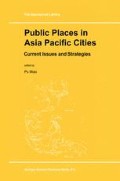Abstract
For two years, I have participated in an urban redevelopment project in central Tokyo. In this project a radical approach which respects and perpetuates the local urban heritage has been experimented on within the tight economic and political constraints usually associated with such urban renewals in today’s Japan. The following narrative will describe in detail the background, process, and techniques involved in this difficult but exciting undertaking.
Access this chapter
Tax calculation will be finalised at checkout
Purchases are for personal use only
Preview
Unable to display preview. Download preview PDF.
Notes
A “Commercial District” is established for promoting commercial and relevant business activities whereas a “Neighborhood Commercial District” is established for promoting business to supply daily goods and stuffs to the neighboring residents.
Teleport City“ was planned to be the new subcenter of Tokyo at the beginning of 1980s. The total space to be created was 700 hectares, of which 250 hectares were for office use, 130 hectares for commercial and service, 205 hectares for residential use and 115 hectares for various supporting use respectively. The subcenter would have been a business community of 60,000 daytime residents. The plan bogged down after the sluggish economy spread all over Japan after the burst of the ”bubble economy.“
Since “Low Town” exists, there should be “High Town” in Tokyo, and Yamanote is the one. “Yama” means “hill” or “hilly” and “note” means “edge” or “side” which spreads over the area in the southwestern part of the central Tokyo (the ward area). Edward Seidensticker’s Low City and High City: Tokyo from Edo to the Earthquake (New York: Knopf, 1983) is a good guidebook to understanding the urban morphology of old Tokyo.
Roger Hamlin and Thomas Lyons, Economy without Walls (Westport, CT: Praeger Publications, 1996), p. 28.
Jane Jacobs, The Death and Life of Great American Cities (New York: Vintage Book, 1961), p. 29.
The purpose of the land readjustment system created by the City Planning Act of 1954 is to construct or improve such public facilities, necessary for everyday life as roads, parks, sewerage, etc. in areas where those are not existing or not well-prepared. To implement this goal, individual estates in the area are often reshaped and the owners have to give up land, sometimes reaching 20% of the roads and streets concerned, without compensation. Naturally, this often drew vigorous opposition in the past, but is still regarded as the most useful technique to improve the quality of jammed urban quarters susceptible to natural disasters.
Planned streets or roads (Toshi-keikaku Dohro) are also created by the City Planning Act of 1954. The total length planned was 62,000 kilometers, but the completion rate is barely 40% due primarily to the high price of land. Those roads are laid out rather forcibly on the map without taking into account the lives of the communities being affected. Among the unfinished roads, some still need to be implemented, but others might not be necessary. Reexamination of the need has not been done, however.
Roger Hamlin and Thomas Lyons, Economy without Walls ( Westport, CT: Praeger Publications, 1996 ), p. 42.
Cliff Moughtin, Urban Design: Street and Square (Oxford, UK: Butterworths, 1992), p. 141.
Anne Mackin and Alex Krieger, A Design Primer for Cities and Towns (Massachusetts Council on the Arts and Humanities, 1989), p. 35.
Author information
Authors and Affiliations
Editor information
Editors and Affiliations
Rights and permissions
Copyright information
© 2001 Springer Science+Business Media Dordrecht
About this chapter
Cite this chapter
Hagiwara, S. (2001). The Alley as a Spiritual Axis for the Community: The Hikifune Project, Tokyo. In: Miao, P. (eds) Public Places in Asia Pacific Cities. The GeoJournal Library, vol 60. Springer, Dordrecht. https://doi.org/10.1007/978-94-017-2815-7_16
Download citation
DOI: https://doi.org/10.1007/978-94-017-2815-7_16
Publisher Name: Springer, Dordrecht
Print ISBN: 978-90-481-5739-6
Online ISBN: 978-94-017-2815-7
eBook Packages: Springer Book Archive

